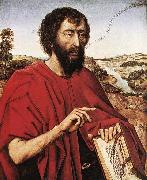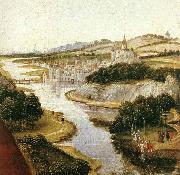WEYDEN, Rogier van der Oil Painting ReproductionAll WEYDEN, Rogier van der Oil PaintingsNetherlandish Northern Renaissance Painter, ca.1400-1464 |
|||

|
|||
|
|
|||
|
||||||||
| WEYDEN, Rogier van der Netherlandish Northern Renaissance Painter, ca.1400-1464 |
||||||||
|
|
||||||||
| Gemälde IDENTIFIZIERUNG:: 63907 Bladelin Triptych 1445-50 Oil on oak panel, 91 x 40 cm Staatliche Museen, Berlin The scenes in the side panels depict the advent of the Son of God on earth being announced in miraculous visions to the Roman emperor Octavian (Augustus) and to the three Magi. The Christ Child receives the homage of both East and West, that is to say the whole world as displayed in the panorama of the open triptych: the West is symbolized by the Roman empire - which was regarded as the direct predecessor of the medieval Holy Roman Empire - the East by the Magi, and between them stands the Holy Land with Bethlehem, to the medieval mind the centre and navel of the world. The visions seen by these ruler are taken from a text popular at the time, but never previously illustrated in this - - the chapter on the Nativity in the Legenda Aurea (Golden Legend, a collection of tales of the saints written around 1270 by the Dominican monk Jacobus de Voragine (1228/29-1298). However, there were certain problems involved in illustrating it in realistic detail. It was particularly difficult to present Octavian's vision of the Madonna on an altar hovering in the sky, not borne up by angels or similar figures. Rogier solved this problem by seating the Virgin on an obviously heavy altar, so closely framed by the opening that she looks almost like a picture within the picture, providing an optical focus. The donor clearly wanted the text of the legend illustrated literally, and he must at first have asked for actual quotations too, although they were eventually omitted, to the benefit of the work as a whole: infrared photography shows that all the scenes originally contained scrolls to hold wording. The left-hand picture, for instance, was to quote the words miraculously heard by Octavian, according to the legend, on seeing the vision: Haec est ara coeli ("This is the altar of Heaven"). However, during the execution of the triptych it obviously became clear that the pictures would make their point even without any explanatory text, and the wording was overpainted. Such a decision cannot have been taken without the consent of the patron who commissioned the altarpiece, and perhaps it may have been made during a conversation between Rogier and his client when the latter visited the artist's studio.Artist:WEYDEN, Rogier van der Title: Bladelin Triptych (left wing) Painted in 1401-1450 , Flemish - - painting : religious |
||||||||
|
|
||||||||
| Gemälde IDENTIFIZIERUNG:: 63908 Braque Family Triptych 1450 Wood, 41 x 34 cm Mus?e du Louvre, Paris The picture shows the left wing of the Braque Family Triptych representing St John the Baptist. The lower frame of pictures (original frame) act as a kind of ledge in front of the figures, where John the Baptist can rest his boo. The words being spoken by the figures proceed from their mouths in curved scroll shapes, rather like the speech bubbles of modern strip cartoons. However, the text above the Magdalene, but not spoken by her, is written in a straight line.Artist:WEYDEN, Rogier van der Title: Braque Family Triptych (left wing) Painted in 1401-1450 , Flemish - - painting : religious |
||||||||
|
|
||||||||
| Gemälde IDENTIFIZIERUNG:: 63909 Braque Family Triptych 1450 Oil on oak panel Mus?e du Louvre, Paris This detail of the left panel shows the baptism of Jesus in the Jordan. John the Baptist's most significant act is shown in the broad Netherlandish landscape behind him. As he baptizes the Son of God, an angel holds Christ's garment. Several onlookers in contemporary urban clothing may be the people mentioned in the Gospels as wising to be baptized, though they have not yet undressed.Artist:WEYDEN, Rogier van der Title: Braque Family Triptych (detail) Painted in 1401-1450 , Flemish - - painting : religious |
||||||||
|
|
||||||||
| Gemälde IDENTIFIZIERUNG:: 63910 St Columba Altarpiece 1455 Oil on oak panel, 138 x 70 cm Alte Pinakothek, Munich The picture shows the Annunciation, the left panel of the altarpiece executed for the St Columba church in Cologne. The angel has entered Mary's chamber through a closed door and is speaking the words "Hail, thou that art highly favoured, the Lord is with thee" in Latin, coming out of his mouth in gold lettering. With its tiled floor, stained-glass window, and the magnificent bed covered with extremely expensive gold brocade, the room is far from a humble dwelling, and seems more suited to a palace.Artist:WEYDEN, Rogier van der Title: St Columba Altarpiece (left panel) Painted in 1401-1450 , Flemish - - painting : religious |
||||||||
|
|
||||||||
| Gemälde IDENTIFIZIERUNG:: 63911 Crucifixion Triptych 1445 Oil on oak panel, 101 x 35 Kunsthistorisches Museum, Vienna The left wing represents Mary Magdalene. The very emotional motif of the Virgin Mary embracing the cross is seldom shown; this dramatic reaction is usually reserved for Mary Magdalene. The Magdalene, however, has assumed a different role here: she stands to the left, entirely withdrawn into herself, more a separate figure than a participant in the event depicted. Curiously, she appears as a matron of fairly advanced years, while Veronica, also isolated in the other wing of the altarpiece, looks more like a Magdalene.Artist:WEYDEN, Rogier van der Title: Crucifixion Triptych (left wing) Painted in 1401-1450 , Flemish - - painting : religious |
||||||||
|
|
||||||||
| VORHERIGER KÜNSTLER NÄCHSTER KÜNSTLER | ||||||||
|
|
||||||||
|
WEYDEN, Rogier van der Netherlandish Northern Renaissance Painter, ca.1400-1464 |
||||||||
|
|
||||||||
|
KONTAKTIEREN Sie UNS |










